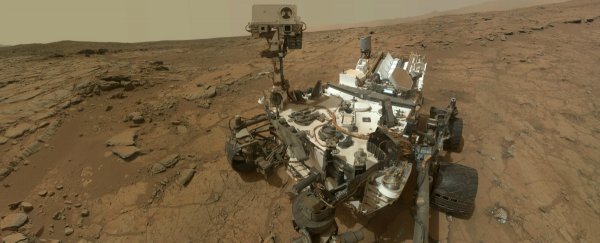NASA's Curiosity Rover has discovered the first traces of nitrates on the surface of Mars, and everyone's kind of freaking out, because it's another piece of evidence that suggests the now-barren Red Planet could once have supported life.
Publishing in the Proceedings of the National Academy of Sciences, the team explains that these nitrogen compounds are essential for the formation of all proteins, as well as RNA and DNA, which means they're crucial for life as we know it. Although this isn't the "smoking gun" evidence for life on other planets that scientists usually focus on - that would be organic carbon, which can only be produced by living things - lead author of the study Jennifer Stern, a NASA geochemist, told Amina Khan from the LA Times that nitrogen is still an important piece of the puzzle.
"People want to follow the carbon, but in many ways nitrogen is just as important a nutrient for life," she told Khan. "Life runs on nitrogen as much as it runs on carbon."
The nitrate in question was detected by Curiosity's Sample Analysis at Mars (SAM) intsrument in the form of nitric oxide, which was believed to have been released by the breakdown of nitrates while the rover heated up Martian rock and dust sediments collected from three locations near its landing site in the Gale Crater. Nitrates (NO3) are a "fixed" form of nitrogen, which means that they can react with other molecules to form life, unlike the nitrogen gas that's abundant in Mars' and Earth's atmospheres.
But it's important to note that there's no evidence the nitrate discovered was produced by living organisms - the team believes it more likely ended up on the Red Planet as a result of meteorite impacts and lightning strikes in the distant past. But there's already evidence that the Gale Crater once contained liquid water and organic matter billions of years ago, and had a potentially habitable climate, and so the discovery of nitrate suggests that life could have formed in the right conditions.
"Finding a biochemically accessible form of nitrogen is more support for the ancient Martian environment at Gale Crater being habitable," said Stern in a press release.
Although certain compounds in the oven-like SAM instrument can also release nitrogen (because the lab was made here on Earth), the amount of nitric oxide they detected is twice of what SAM could be expected to release even in the most extreme circumstances, Stern explained in the release. And even after adjusting for this potential contamination, there is still an abundant amount of nitrates present in the sediment - up to 1,100 parts per million. As Khan explains for the LA Times, that's comparable to the amount of nitrate you'd find in really dry places on Earth, like the Atacama Desert in South America.
The site with the highest nitrate content, the Cumberland drill site in Mars's Yellowknife Bay, has also been shown to have once contained fresh water, key chemicals required for life and a potential energy source that could have supported simple microorganisms.
"Scientists have long thought that nitrates would be produced on Mars from the energy released in meteorite impacts, and the amounts we found agree well with estimates from this process," said Stern in the release.
The next step is for the researchers to find out whether there's an ongoing process that is ripping these nitrogen molecules from the Martian atmosphere and fixing them as nitrates on the Red Planet's surface, or whether it was a process that happened in the distant past. And if we can work out how long ago they go there, we could begin to unravel whether they would have been there at just the right time and in just the right conditions to potentially create life. Guys, this is pretty exciting stuff.
Source: LA Times
